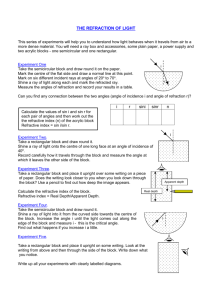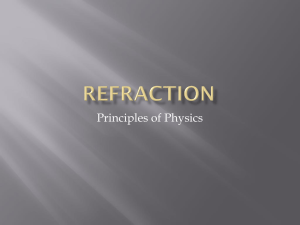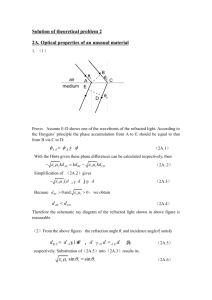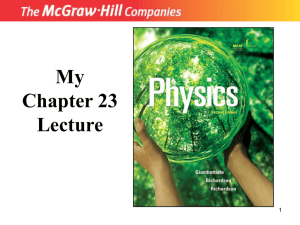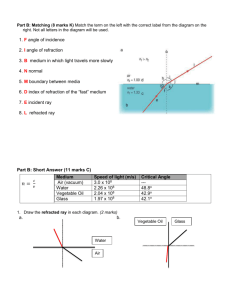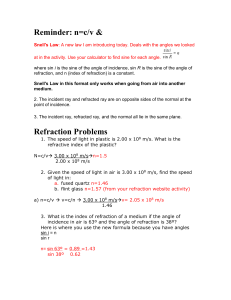Physics 1C - UCSD Department of Physics
advertisement
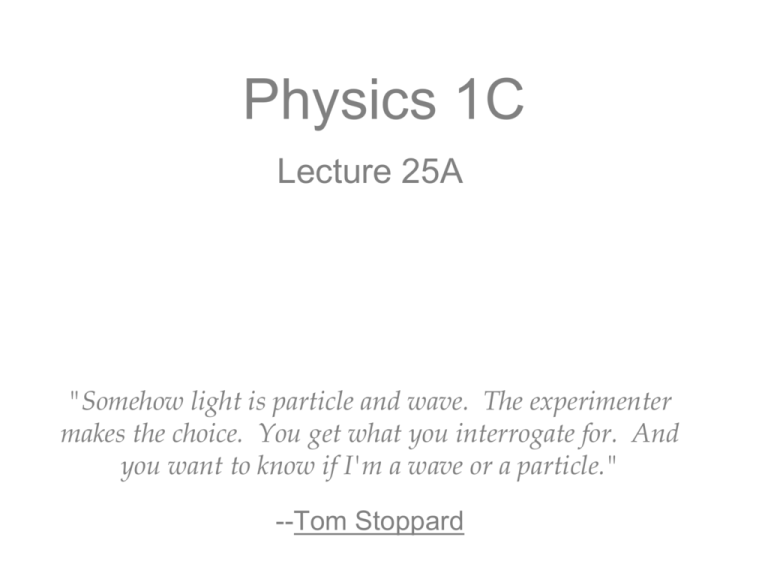
Physics 1C Lecture 25A "Somehow light is particle and wave. The experimenter makes the choice. You get what you interrogate for. And you want to know if I'm a wave or a particle." --Tom Stoppard Quiz 2 Info It will be on Friday It is a Scantron test that covers Chapters 13 and 14. A list of equations, constants, and conversions are available on the website and will be provided on the quiz. You are to write the version of your test on the Scantron form. Get it right to get credit. You will need your student ID. You are expected to abide by UC Policy on Integrity of Scholarship. Last Time Spherical Waves Doppler effect Polarization Nature of light & Light Rays Today Nature of light & Light Rays Reflection Refraction Total internal reflection The Nature of Light The incident light ray will move in a straight line path as long as the medium does not change. But, when it encounters a boundary with a second medium, (at least) part of this incident ray is reflected back into the first medium. If the boundary is a smooth surface, the reflection is known as specular reflection. This means all the reflected rays will be parallel to one another. The Nature of Light If the boundary is a rough surface, the reflection is known as diffuse reflection. This means that the reflected rays will travel in a variety of directions. Diffuse reflection is how you can see most everyday objects. Although diffuse reflection is more common, it is harder to mathematically model than specular reflection. Law of Reflection We define a normal (perpendicular line to the surface) at the point where the incident ray hits strikes the surface. The incident angle, θ1, is the angle that the incident ray makes with respect to the normal. The reflected angle, θ’1, is the angle that the reflected ray makes with respect to the normal. The angle of incidence is equal to the angle of reflection. 1 1 1 1' Refraction of Light Also, when an incident ray of light in a medium encounters a boundary with a second medium, part of this incident ray may enter the second medium. The ray that enters the second medium is bent at the boundary. This bending of the ray is called refraction. The incident ray, the reflected ray, the refracted ray, and the normal all lie in the same plane. Refraction of Light For example, let’s look at red laser light incident upon a block of lucite. Ray 1 is called the incident ray Ray 2 is the reflected ray from the air/lucite boundary. Ray 3 is refracted into the lucite. Ray 4 is the reflected ray from the bottom lucite boundary. Ray 5 is refracted into the air. Sunset Moth from Madagascar Wings actually have no pigmentation. Colors come from reflection of light from the micro-ribbons in its wings This insect is active during the daytime when the bright colors warn predators. Their wings change color from blue to green and golden yellow color when viewed from different sides. Refraction of Light When light passes from one medium to another, it is refracted because the speed of light is different in the two media. The index of refraction, n, of a medium can be defined: n is a unitless ratio (n is not necessarily an integer in this context!) For a vacuum, n=1 (exactly). For all other media, n>1. Indices of Refraction Frequency Between Media As light travels from one medium to another, its frequency does not change. Both the wave speed and the wavelength do change. The wavefronts do not pile up, nor are created nor destroyed at the boundary, so the frequency must stay the same. 1 n 2 2 n1 Snell’s Law “Fast to slow, light bends towards the normal.” Or think of a car axle: one wheel stuck in mud (slow), other wheel on pavement (fast) pivots around. “Slow to fast, light bends away from the normal.” This is the basis for Snell’s Law. Refraction of Light The angle of refraction depends upon the material (by index of refraction) and the angle of incidence: n1 sin1 n2 sin2 where θ1 is the angle of incidence (30o in the diagram). θ2 is the angle of refraction. n1, n2 are the indices of refraction of the first and second media, respectively. Snell’s Law For example, for this specific case (air to glass with an incident angle of 30.0o): n1 sin1 n2 sin2 n1 sin 2 sin 1 n2 n 1 2 sin 1 sin1 n 2 1.0003 2 sin sin 30 1.52 1 2 sin 0.329 19.2 1 Clicker Question 25A-1 A light ray travels from medium 1 to medium 3 as shown in the figure below. What can we say about the relationship between the index of refraction for medium 1 (n1) and the index of refraction for medium 3 (n3)? A) n3 > n1. B) n3 = n1. C) n3 < n1. D) We cannot compare n1 to n3 without knowing n2. Clicker Question: Discussion Use Snell’s Law twice: Use the two Equations to eliminate n2: 30o Clicker Question: Discussion 2nd way to solve the same problem Use Snell’s Law twice: Drop the part with n2 that you do not actually need Show that since sin10º < sin20º 3rd way: Eliminate material 2 from consideration Notice that ray 3 goes closer to the normal than ray 1 Speed of light in medium 1 is faster than in medium 3 (fast to slow) Refraction of Light We calculated the angle of refraction going from air to glass. What if instead of going from air to glass with an incident angle of 30o, it went from glass to air with the same incident angle: n1 sin1 n2 sin2 n1 sin 2 sin 1 n2 n 1 1.52 1 1 sin 30 2 sin sin1 2 sin 1.0003 n 2 sin10.760 49.4 2 Here the angle increased (slow to fast). Refraction of Light What if instead having an incident angle of 30.0o (from glass to air) it had an incident angle of 60.0o (still glass to air): n1 sin1 n2 sin2 n1 sin 2 sin 1 n2 n1 1.52 2 sin sin1 2 sin1 sin60 n 2 1.0003 1 2 sin 1.32 ????? 1 Here the angle doesn’t exist. The angle was so great that it refracted the incident ray back to the first medium (reflected?). Total Internal Reflection This is known as Total Internal Reflection (TIR). It can only occur if you move from a slow medium to a fast medium such that the refracted ray is bent away from the normal compared to the incident ray. Here you can see light ray 5 undergoing total internal reflection. This means that at angle that light ray 5 hits at, no light enters the second medium. Total Internal Reflection We define the critical angle as a particular angle of incidence that will result in an angle of refraction of 90o. For angles of incidence greater than the critical angle, the beam is entirely reflected at the boundary (TIR). This ray will obey the Law of Reflection at the surface boundary. For Next Time (FNT) Quiz on Friday Continue reading Chapter 25 Finish working on the homework for Chapter 24


